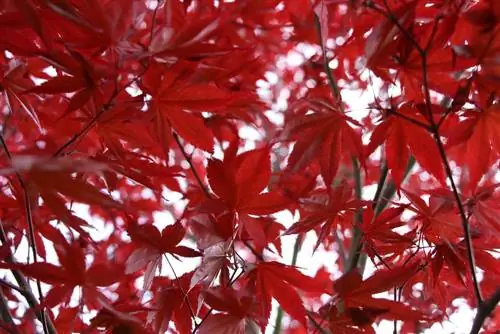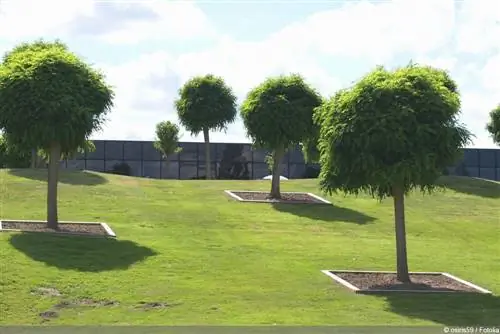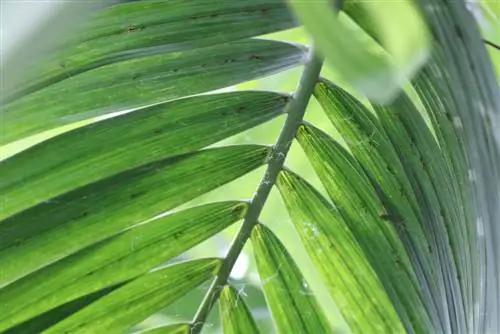- Author admin [email protected].
- Public 2023-12-17 03:39.
- Last modified 2025-01-24 12:45.
With the native Norway maple as the ancestor, red ball maple can rely on its home advantage with reliable winter hardiness. In order for the spectacular head refinement to develop into an impressive house tree, important aspects of cultivation are important. Location, soil quality, pruning care, water and nutrient supply make an important contribution to he althy, shapely growth. This guide deepens the basics of care with practical tips and useful information. This is how red-leaved maple maple develops into a magnificent specimen.
Location and soil quality
Red ball maple demonstrates its home advantage when choosing a location. The picturesque deciduous tree has proven to be tolerant of heat and urban climates, coupled with a pronounced tolerance to light and temperature conditions. In order for the representative Acer platanoides 'Crimson Sentry' to show its most beautiful side, the following conditions offer ideal conditions:
- Sunny to partially shaded location
- Ideally in the slipstream, but not a compelling premise
- Normal, nutritious bed soil, preferably loamy-sandy and calcareous
- Loose soil structure, permeable and without the threat of waterlogging
The list of undesirable location conditions is significantly shorter. In acidic, boggy-wet soil on the cold, light-poor north side, red-leaved globe maple loses its courage to live and does not live up to its good reputation as a magnificent specimen.
Tip:
Home gardeners with families have had concerns about maple trees since sycamore maple seeds are believed to be the cause of the sudden death of horses on grazing. A Dutch team of researchers examined in detail whether other maple species also contain toxic substances and gave the all-clear. Norway maple and its magnificent globe maple varieties 'Globosum' and 'Crimson Sentry' are non-toxic and perfect as a house tree for the family garden.
Planting time
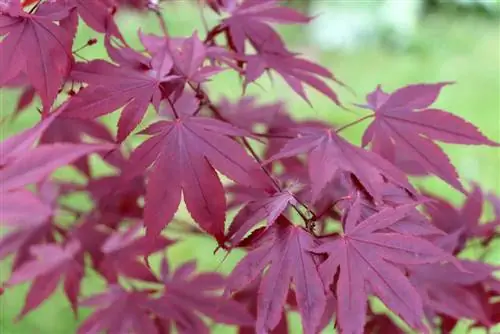
The best planting time for ball maple 'Crimson Sentry' is in autumn. In the warm, sunny soil of September and October, your new house tree will find ideal conditions for a he althy and vital start to floral life. If you purchased a young tree as a container plant in spring or summer, there is nothing wrong with planting it immediately. The planting date should only be postponed if there is bitter frost or summer drought.
Plants
With careful soil preparation, you can set the course for a flawless planting process. Dig a pit equal to twice the volume of the bale. Please enrich the excavation by a third with mature compost and a few handfuls of horn shavings. To control the spread of the predominantly shallow root system, line the planting pit with a root barrier that is about 30 cm deep and extends 5 to 10 cm above the edge of the ground. Your new tree will spend the waiting time in a bucket of water. As long as air bubbles rise, the root ball can be soaked in water. The cultivation pot is only removed shortly before planting. This is how the workflow continues:
- Drive a support post into the planting hole that reaches half the height of the crown
- Position the unpotted bale in the middle of the pit
- Important: the bale surface is a maximum of 5 cm below the bed surface
- Form a watering edge by hand for optimal watering
Fill the pit gradually with the enriched substrate. To prevent cavities from forming, tamp down the soil in the meantime without compacting it massively. Generously watering marks the end of the planting work. A 5 cm high layer of bark mulch, compost or autumn leaves is recommended. Finally, connect the support post and trunk with wide binding material to protect the freshly planted maple tree from wind.
Pouring
In the first few weeks after planting, adequate water supply plays a key role in care. Rain clouds don't provide enough moisture, so please water abundantly and regularly. Let the water run onto the root disk until the first puddles appear, signaling that the soil is saturated. Waterlogging is just as detrimental to growth as drought stress. If the red maple has become well rooted in the soil, the water requirement is reduced to watering in dry conditions because the deep and extensive root system of the heart root has penetrated to the reserves in the soil.
Fertilize
Provide your red-leaved Acer platanoides with organic fertilizer once a year. Equipped with a balanced nutrient balance, the deciduous tree is well prepared for winter hardships and can rely on robust defenses if pathogens should attack. How to properly fertilize your red 'Crimson Sentry':
- Best time is early fall during the months of August and September
- Distribute 3 liters of mature compost per square meter of tree disc
- Carefully incorporate fertilizer with the rake without causing root damage
- Bubbling with potassium-rich plant manure made from comfrey leaves
The combination of natural nutrient buffet and potassium is just right for your house tree in autumn. By spring, hard-working soil organisms have processed the compost to such an extent that its ingredients are available to the tree. Just in time for the new season, all the energy reserves are available for the red maple tree so that it can once again put on its colorful foliage. The main nutrient potassium becomes active in winter to strengthen cell tissue and lower the freezing point in plant sap.
Tip:
Home gardeners without their own compost heap resort to packaged goods from the garden center. Patent potassium or potassium magnesia is used as a substitute for comfrey manure.
Cutting
The red-leaved 'Crimson Sentry' does not form a spherical crown by itself, like its green-leaved counterpart Acer platanoides 'Globosum'. By nature, red ball maple tends to have an oval to ovoid crown shape. You can give this pursuit free rein and enjoy the silhouette. As a second option, you can direct the growth in the desired direction with planned pruning measures. The main criterion for the ideal time is the sap flow. In early autumn, the high sap pressure that is characteristic of all maple species briefly decreases, so that the tree bleeds little after pruning. This is how you prune red-leaved maple maple in an exemplary manner:
- Best time is the end of September to the end of October
- Sharpen pruning shears and disinfect with alcohol
- Thinning out damaged, dead and inward-facing branches
- Cut back shoots that protrude out of shape in the area as thick as your thumb
- Choose the cutting point at a short distance (3-5 mm) from buds that point outwards
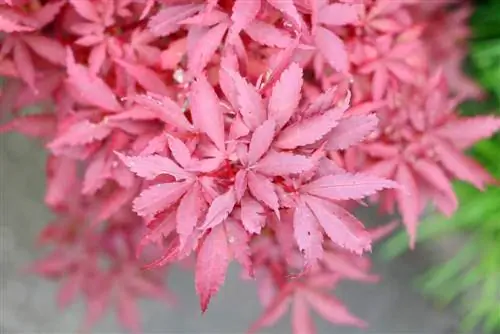
Don't you see any reason to interfere with the natural crown formation? Pruning care is then reduced to occasional thinning out of dead wood. For this purpose, every two to three years in the fall, remove those shoots that no longer contribute to the well-groomed appearance. Use a handy folding saw to cut off the relevant branches in front of the branch ring. You can recognize the branch ring as a bulging thickening in the transition from the branch to the trunk.
Tip:
A test cut provides information about the ideal cutting date on the red-leaved maple maple. Cut off a piece of two thin, finger-thick shoots and observe the flow of sap. If only a little sap comes out, the tree gives the green light for pruning. Massive bleeding signals that the timing should be postponed for one to two weeks.
Wintering
The issue of winter protection is primarily important in the first two years of operation. By then, an adult red globe maple tree has established itself at the site to the point where it can withstand the bitter cold on its own. How to properly overwinter your red-leaved 'Crimson Sentry':
- Pile leaves on the tree disc before the onset of winter
- Fix with needle sticks
- Alternatively layer compost or bark mulch
The young trunk bark is susceptible to cracks. When blazing sunshine hits the bark at temperatures below freezing, the tissue cannot withstand the stress and tears. You can prevent this dilemma by wrapping the trunk with jute ribbons or garden fleece. Wooden slats or reed mats are also sufficient to protect the sensitive trunk tissue from a winter test.
Transplanting
Due to certain circumstances, it may be necessary to expand the normal care program to include a change of location. At least in the first five years of its existence, a red maple tree will forgive you if it has to leave its usual place. To ensure that you successfully transplant the deciduous tree, follow these steps:
- The best time is after the leaves fall in autumn
- Thin out some of the thickest, oldest branches on Astring
- Cut the crown back by a maximum of a third
- Pick off the root disc in a large radius (3/4 of the growth height)
- Expand the cut area to a 10 cm wide furrow
- From this furrow, cut off any remaining roots and loosen the ball
Use your combined strength to lift the red maple tree out of the ground. Immediately cover the root ball with a jute bag to take the valuable soil with you to the new location. The recommended pruning before relocation has two important functions. The weight of the tree is significantly reduced, which noticeably reduces the effort required for you and your helpers. Furthermore, this way you can compensate for the lost root mass.
Diseases
If home gardeners follow the basics of care, red maple maple rarely becomes a target for pathogens. However, red-leaved 'Crimson Sentry' is not completely immune to plant diseases. The focus is on three infections that can cause problems for the elegant deciduous tree. Find out about typical symptoms and tried-and-tested tips for combating them here:
Tar spot disease
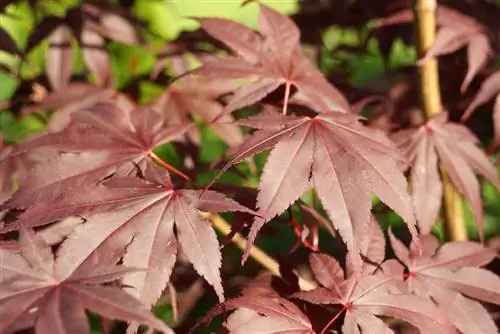
It starts at the beginning of summer. Yellow spots spread on the dark red decorative leaves. When the bright yellow autumn color develops, the spots take on a black color, which is what the name of the fungal infection refers to. Instead of competing with the golden October sun, the leaves fall off prematurely. The good news is that you don't have to resort to chemical fungicides to control tar spot. It is important to interrupt the fatal development cycle. To do this, remove all leaves to burn or dispose of in household waste.
Red pustule disease
One of the most common diseases of the red-leaved maple tree acts as a weakness parasite. The symptoms cannot be overlooked. Vermilion-colored pustules spread across tree bark and shoots. Without countermeasures, cancerous growths form. How to combat the dreaded red pustule disease:
- In September, cut back the entire crown down to he althy wood
- Cutting guide: 15-20 cm below the infestation and 3-5 mm above a leaf or eye
- Carefully clean and disinfect cutting tools before and after
The pathogens that cause red pustule disease primarily target globe maple trees that have been weakened by care errors. Put all framework conditions to the test in order to identify and correct weak points.
Mildew
The large lobed leaves magically attract mildew spores. An infestation can be recognized by the mealy-white fungal growth on the tops of the leaves and yellowish pustules on the undersides of the leaves. A powerful remedy is in your fridge. Fresh milk contains lecithin and microorganisms that make short work of fungal spores.
Tip:
Mix 1 liter of decalcified water with 1/8 liter of fresh milk (not UHT milk). Before you spray the milk-water, cut off affected parts of the plant. Spray the crown dripping wet with the home remedy at intervals of 3 to 4 days.

